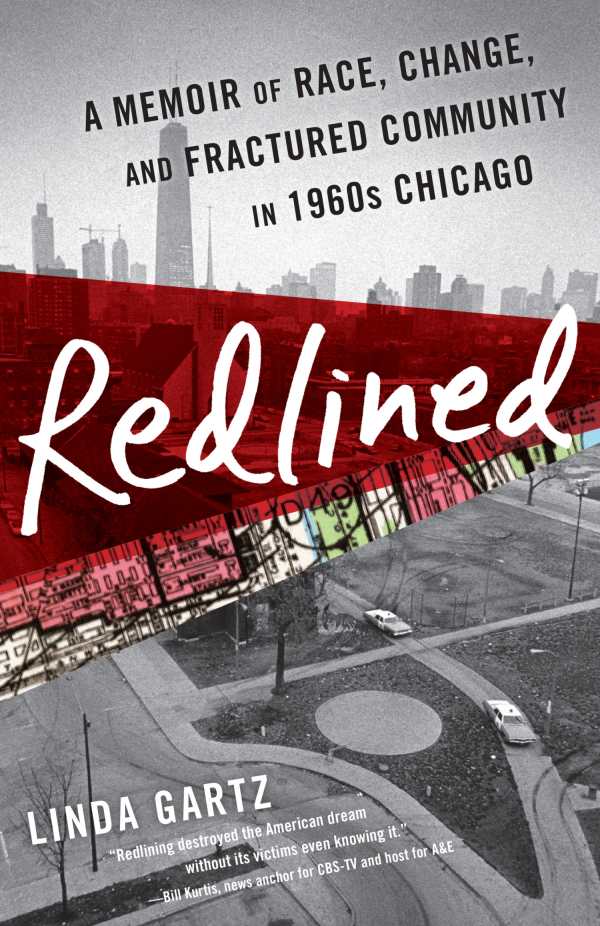Redlined
A Memoir of Race, Change, and Fractured Community in 1960s Chicago
- 2018 INDIES Finalist
- Finalist, Family & Relationships (Adult Nonfiction)
- 2018 INDIES Finalist
- Finalist, Multicultural (Adult Nonfiction)
Redlined offers a nuanced look at ordinary Americans during an event-laden era.
Linda Gartz’s Redlined is an exceptionally rich and readable memoir of family, change, and coming of age in the tumultuous 1960s.
While clearing out the family home after her mother’s death, Linda Gartz found a voluminous trove of diaries and correspondence left by her parents. From that material and her own experiences growing up, Gartz weaves a vivid portrait of how rapid changes brought by integration and turbulent times affected one neighborhood and many families.
With World War II behind them, Lil and Fred Gartz set about building the American dream. They bought property in a stable, all-white Chicago neighborhood and endured cramped quarters to rent their unused rooms. Fred’s job involved long trips away from home; Lil kept busy raising three kids, caring for her mentally troubled mother, and seeing to the management and upkeep of an increasing number of rental units.
The Great Migration brought tens of thousands of black Americans to Chicago after World War II. During the 1950s and 1960s, federal policies continued to quietly color-code communities with black residents living in them, making property loans impossible to acquire. Neighborhoods like the Gartzes’ changed, with many white residents moving out as black residents moved in.
The writing throughout the book is clear, detailed, and never overly sentimental. The many sources of pressure in the Gartz home create reader empathy without hinting at victimhood. With the aid of maps and facts, the narrative shows how the pernicious practice of redlining took advantage of both black and white Americans by rezoning to drive down home values in long-established white communities, scooping up houses of longtime residents at bargain discounts, then selling them to black families at unreasonably high prices. Through the experiences of the Gartz family, the book shows how both those who stayed and the new arrivals were punished by forces beyond their control.
Redlined sets a steady pace and holds reader interest by embracing several main themes. In addition to portraying a marriage that survived more than its share of stress, and the consequence-laden decline of an urban neighborhood, it also shows, through the narrator’s eyes, what it was like to grow up in the 1960s, to be born into a relatively stable picket-fence world and navigate young adulthood in a world marked by war protests, race riots, assassinations, free love, and the counterculture. The book shifts easily from one focus to another, weaving a seamless tapestry that offers a credible panorama of an entire era.
Characters are fully developed throughout, particularly in the case of the narrator’s parents and their marriage. The book includes snippets of the diaries kept by each and of their letters, allowing a rare look at two people whose goals and needs often collided and whose resentments sometimes boiled to the surface but who never, on either side, decided to throw in the towel. In deft brushstrokes the book also conveys a sense of minor characters. When the narrator is about to depart to study abroad, her paternal grandmother refuses to attend the bon voyage party, saying, “She hasn’t earned the right to go to Europe!”
A nice coda to the memoir returns to the book’s starting point: the discovery of diaries and letters, and a grown child’s experience of viewing—and understanding—her parents’ lives from an adult perspective.
Well written and amplified with pictures, notes, and maps, Redlined goes beyond the title to offer a nuanced look at ordinary Americans during an event-laden era.
Reviewed by
Susan Waggoner
Disclosure: This article is not an endorsement, but a review. The publisher of this book provided free copies of the book and paid a small fee to have their book reviewed by a professional reviewer. Foreword Reviews and Clarion Reviews make no guarantee that the publisher will receive a positive review. Foreword Magazine, Inc. is disclosing this in accordance with the Federal Trade Commission’s 16 CFR, Part 255.

